NCERT Solutions for Class 12 Micro Economics Cost
NCERT Solutions for Class 12 Micro Economics Cost
NCERT TEXTBOOK QUESTIONS SOLVED
Question 1. Briefly explain the concept of the cost function.[1 Mark]
Answer: Cost function shows functional relationship between output and cost of production. It gives the least cost combination of inputs corresponding to different levels of output. Cost function is given as:
C = f(X), ceteris paribus,
where, C = Cost and X = Output
Question 2. What are total fixed cost, total variable cost and total cost of a firm? How are they related?
Or
Draw TVC, TC, and TFC curves in a single diagram. [AI 2012][CBSE Sample Paper 2013][3 Marks]
Answer: (i) TC is divided into two parts TFC and TVC such that TC = TFC + TVC.
(ii) TFC is the overhead cost and it remains constant or fixed whatever be the level of output. TFC curve is a horizontal line parallel to the x-axis.
(iii) TVC is cost due to increased use of variable factors like raw material, labour, etc. TVC is inverse S-shaped starting from the origin due to law of variable proportion.
(iv) TC is aggregate of TFC and TVC. TC curve is inverse S-shaped starting from the level of fixed cost. The reason behind it shape is the law of variable proportion.
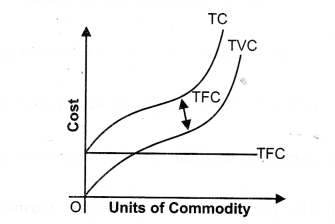
Question 3. What are the average fixed cost, average variable cost and average cost of a firm? How are they related?[3-4 Marks]
Answer: AFC: The per unit cost incurred on fixed factors of production is known as average fixed cost.
AFC=TFCQ
AFC always decreases as the firm increases the level of production. AVC: It is variable cost per unit of output produced.
AC=TCQ It is obtained by dividing the total variable cost by the quantity of output.
AVC initially decreases. But after reaching the stage of minimum cost it starts increasing. AVC is U-Shaped. AC: It is cost per unit of output produced. It can be obtained by dividing the total cost by the quantity of output produced.
Relationship between AFC, AVC and AC. There is a unique relationship among AC, AFC and AVC. AC is the sum of AFC and AVC, i.e.,
AC = AFC + AVC.
Question 4. Can there be some fixed cost in the long run? If not, why? [1 Mark]
Answer: No, there are no fixed costs in the long run as all the factors become variable. Fixed cost exists only in short run.
Question 5. What does the average fixed cost curve
look like? Why does it look so?[3 Marks] Or
How does AFC behave as output is increased? [CBSE 2009C]
Or
What is the behaviour of average fixed cost as output increases?
[CBSE 2012]
Answer: The shape of AFC is downward sloping Rectangular hyperbola. AFC
falls as output increases because TFC=TFCOutput and TFC remains Output constant. So, as output increases, TFC remains constant, but AFC falls.
Question 6. What do the short run marginal cost, average variable cost and short run average cost curves look like?[1 Mark]
Answer: The Short run marginal cost, average variable cost and short run average cost curves are U-shaped because of Law of variable proportion.
Question 7. Why does SMC curve cut AVC curve at the minimum point of AVC curve?[3 Marks]
Answer: (i) It happens because when AVC falls, SMC is less than AVC.
(ii) When AVC starts rising, SMC is more than AVC.
(iii) So, it is only when AVC is constant and at its minimum point, that SMC is equal to AVC. Therefore, SMC curve cuts AVC curve at its minimum point.
Question 8. At which point does the SMC curve cut the SAC curve? Give reason in support of your answer.[3 Marks]
Answer: (i) It happens because when SAC falls, SMC is less than SAC.
(ii) When SAC starts rising, SMC is more than SAC.
(iii) So, it is only when SAC is constant and at its minimum point, that SMC is equal to SAC. Therefore, SMC curve cuts SAC curve at its minimum point.
Question 9. Why is the short run marginal cost curve U- Shaped? [3 Marks]
Answer: Marginal cost is U-shaped because of Law of variable proportion:
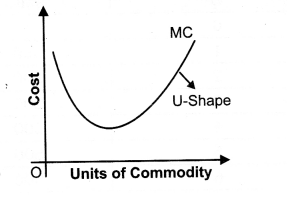
(i) As we know the shape of MC depends on the shape of TVC or TC. Let us suppose TVC.
(ii) Initially, TVC increases at a diminishing rate (Total Product increases at Increasing rate), which makes the gap of TVC, i.e. MC to fall.
(iii) Thereafter, TVC increases at an increasing rate( Total Product increases at diminishing rate) which makes the marginal cost to rise.
(iv) So, from inverse S-shape TVC curve, we derive U-shape MC curve.
Question 10. What do the long run marginal cost and average cost curves look like?
Answer: Out Of Syllabus.
Question 11. The following table shows the total cost schedule of a firm. What is the total fixed cost schedule of this firm?
Calculate the TVC, AFC, AVC, SAC and SMC schedules of the firm.[6 Marks]
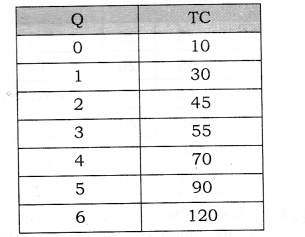
Answer: The total fixed cost will be the same at all the levels of output ranging from zero to six. For zero output, total cost is ? 10. At zero output, total variable cost will be zero. Hence, Rs. 10 represents total fixed cost at all levels of output.
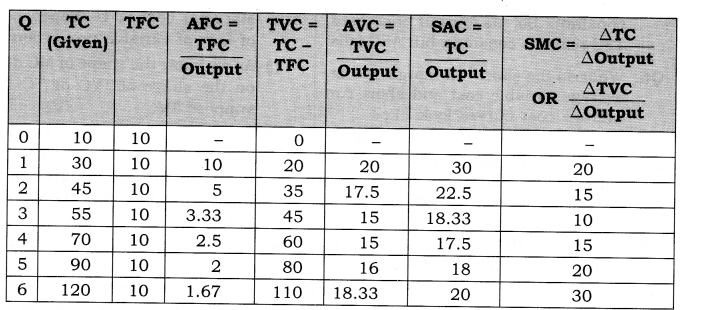
Question 12. The following table gives the total cost schedule of a firm. It Is also given that the average fixed cost at 4 units of output is Rs. 5.
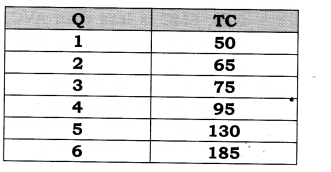
Find the TVC, TFC. AVC, AFC, SAC and SMC schedules of the firm for the corresponding values of output.[6 Marks]
Answer:
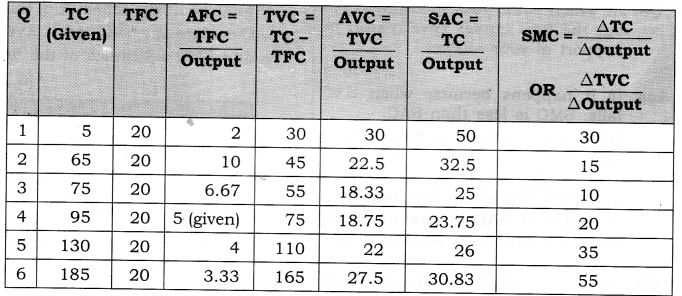
Question 13. A firm’s SMC schedule is shown in the following table. The total fixed cost of the firm is Rs. 100.
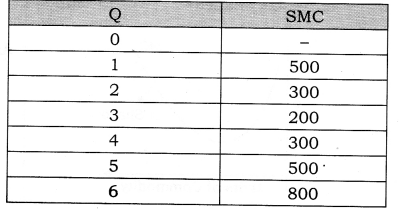
Find the TVC, TC, AVC and SAC schedules of the firm.[6 Marks]
Answer:
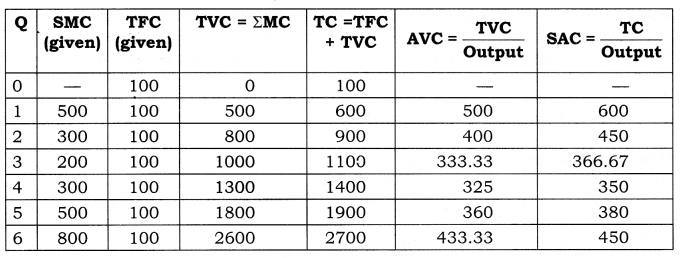
MORE QUESTIONS SOLVED
I. Very Short Answer Type Questions (1 Mark)
Question 1. Give the meaning of cost.Or [CBSE 2007]
What is meant by cost in economics? [CBSE, Sample Paper 2010} Or
What does ‘cost’ mean in economics? [CBSE 2008]
Answer: Cost of producing a good, in economics, is the sum total of explicit cost, implicit cost and certain minimum profit (normal profit).
Question 2. Give two examples of fixed cost.[ CBSE 2013]
Answer: (i) Rent of the building.
(ii) Salary of permanent employees.
Question 3. Give two examples of variable costs.
Answer: (i) Raw materials.
(ii) Labour engaged on production.
Question 4. Why is average total cost greater than average variable cost?
Answer: Because AC is sum total of AFC and AVC.
Question 5. What is meant by total cost?
Answer: During production the expenditure incurred on various factors of production is known as total cost.
Question 6. Why are TC and TVC curves parallel to each other?
Answer: TC and TVC curves are parallel to each other because the vertical gap
between them represents TFC which remains constant at all levels of output.
Question 7. How does the total fixed cost change when output changes? [CBSE 2003]
Answer: Total fixed cost does not change with the change in output.
Question 8. Give the meaning of marginal cost. [CBSE, Sample Paper 2010]
Answer: The cost incurred on additional unit of output is known as Marginal cost.
Question 9. How is MC related to TFC?
Answer: MC is independent (not related) of TFC and is affected by change in only TVC.
Question 10. How is TVC derived from MC schedule?
Answer: TVC = SMC
Question 11. What does the area under marginal cost curve show?
Answer: Area under marginal cost curve shows total variable cost.
Question 12. Can AC be less than MC when AC is rising?
Answer: Yes, AC can be less than MC, when AC is rising, as long as MC is more than AC.
Question 13. When AC curve slopes downwards, what will be the position of MC curve?
Answer: MC curve is below AC curve.
Question 14. What happens to AC when MC is equal to AC?
Answer: AC is constant and at its minimum point.
Question 15. Can AC and AVC curves touch each other?
Answer: No, because difference between AC and AVC is AFC and AFC can never be zero.
Question 16. Give two examples of explicit cost.
Answer: The two examples are: (i) Wages to worker by a firm, and (ii) rent to landlord by a firm.
Question 17. Give two examples of implicit cost of a firm.
Answer: The two examples are: (i) imputed cost of the seller’s self-owned shop; and (ii) imputed cost of family labour being used free by the seller.
Question 18. What is the behaviour of Total Variable Cost, as output increases? [AI 2012]
Answer: TVC first increases at a diminishing rate and then increases at an increasing rate.
Question 19. If it is given that the total variable cost for producing 15 units of output is Rs. 3000 and for 16 units is Rs. 3,500. Find the value of Marginal Cost. [CBSE, Sample Paper 2016]
Answer: MCn = TVCn-TVCn-1
MC16 =TVC16 – TVC15
=3500 – 3000 =500
II. Multiple Choice Questions (1 Mark)
Question 1. Which cost increases continuously with the increase in production?
(a) Average cost, (b) Marginal cost.
(c) Fixed cost. (d) Variable cost.
Answer: (d)
Question 2. Which one of the following cost curves is never ‘U’ shaped?
(a) Average cost curve.
(b) Marginal cost curve.
(c) Average variable cost curve.
(d) Average fixed cost curve.
Answer: (d)
Question 3. Total cost in the short run is classified into fixed costs and variable costs. Which one of the following is a variable cost?
(a) Cost of raw materials.
(b) Cost of equipment.
(c) Interest payment on past borrowings.
(d) Payment of rent on building.
Answer: (a)
Question 4. In the short run, when the output of a firm increases, its average fixed cost:
(a) increases.
(b) decreases.
(c) remains constant.
(d) first declines and then rises.
Answer: (b)
Question 5. Which one of the following statements
is correct?
(a) When the marginal cost is rising, the average cost must also be rising.
(b) When the average cost is rising, the marginal cost must be falling.
(c) When the average cost is rising, the marginal cost is above the average cost.
(d) When the average cost is falling, the marginal cost must be rising.
Answer: (c)
Question 6. Which one of the following statements is an example of “explicit cost”?
(a) The wages a proprietor could have made by working as an employee of a large firm.
(b) The income that could have been earned in alternative uses by the resources owned by the firm.
(c) The payment of wages by the firm.
(d) The normal profit earned by a firm.
Answer: (c)
Question 7. Which one of the following statements
is an example of an “implicit cost”?
(a) Interest that could have been earned on retained earnings used by the firm to finance expansion.
(b) The payment of rent by the firm for the building in which it is housed.
(c) The interest payment made by the firm for funds borrowed from a bank.
(d) The payment of wages by the firm.
Answer: (a)
Question 8. Marginal cost is defined as:
(a) The change in total cost due to a one unit change in output.
(b) Total cost divided by output.
(c) The change in output due to a one unit change in an input.
(d)Total product divided by the quantity of input.
Answer: (a)
Question 9. Which one of the following statements is true to the relationship between marginal cost function and average cost function?
(a) If MC is greater than ATC, ATC is falling.
(b) ATC curve intersects MC curve at minimum MC.
(c) MC curve intersects ATC curve at minimum ATC.
(d) If MC is less than ATC, ATC is increasing.
Answer: (c)
Question 10. Which one of the following statements is true to the relationship among the average cost functions?
(a) ATC = AFC – AVC.
(b) AVC = AFC + ATC.
(c) AFC = ATC + AVC.
(d) AFC = ATC – AVC.
Answer: (d)
Question 11. Which one of the following elements is not a determinant of the firm’s cost function?
(a) The production function.
(b) The price of labour. (c) Taxes.
(d) The price of the firm’s output.
Answer: (d)
Question 12. Which one of the following statements is correct concerning the relationships among the firm’s cost functions?
(a) ATC=AFC-AVC
(b) AVC = AFC + ATC.
(c) AFC = ATC + TVC.
(d) AFC = ATC – AVC.
Answer: (c)
Question 13. Suppose output increases in the short run, than the Total cost will:
(a) increase due to an increase in fixed costs only.
(b) increase due to an increase invariable costs only.
(c) increase due to an increase in bothfixed and variable costs.
(d) decrease if the firm is in the regionof diminishing returns.
Answer: (b)
Question 14. A firm’s average fixed cost is Rs.20 at 6 units of output. What will it be at 4 units of output?
(a) Rs.60 (b) Rs.30
(c) Rs.40 (d) Rs.20
Answer: (b)
Question 15. If marginal cost equals to average total cost,
(a) average total cost is falling
(b) average total cost is rising
(c) average total cost is maximized
(d) average total cost is minimized
Answer: (d)
Question 16. When marginal costs are below
average total costs,
(a) average fixed costs are rising
(b) average total costs are falling
(c) average total costs are rising
(d) average total costs are minimized
Answer: (b)
Question 17. If the average cost is falling,
(a) marginal cost is rising
(b) marginal cost is falling
(c) marginal cost is equal to average cost
(d) it is impossible to tell if marginal cost is rising or falling
Answer: (d)
Question 18. The difference between average total cost and average variable cost:
(a) is constant
(b) is total fixed cost
(c) gets narrow as output decreases
(d) is the average fixed cost
Answer: (d)
Question 19. If the total cost curve is parallel to X-axis, marginal cost will:
(a) increase (b) decrease
(c) zero (d) None of these.
Answer: (c)
Question 20. The total cost at 5 units of output is Rs. 30. The fixed cost is Rs. 5. The average variable cost at 5 units of output is: [CBSE Sample Paper 2014]
(a)Rs.25 (b)Rs.6
(c)Rs.5 (d)Rs.1
Answer: (c)
III. Short Answer Type Questions (3-4 Marks)
Question 1. Define total fixed cost (Supplement/ Indirect/overhead cost).
Or
Define fixed cost.[AI 2004, 06, 07; CBSE 2008C, 09] Or
What is meant by fixed (supplementary) costs of a firm? Give examples.
[AI 2007; CBSE 2004, 04C, 07C]
Answer: (i) Fixed costs are those costs of production which do not change with a change in output.
(ii) These are the costs incurred on fixed factors, like rent of land and building, interest, etc. These are unavoidable contractual costs.
(iii) Fixed costs are also called overhead costs or general costs because these are common for all the units produced. These costs are also called supplementary costs or indirect costs.
(iv) The shape of Total fixed Cost is horizontal (Parallel to X-Axis). They have to be incurred when the output is large or small or even zero.
Question 2. What is meant by variable (prime) cost of a firm? Give examples. [CBSE 2004 C; AI 2004]
Answer: (i) The cost incurred on variable factors of production is known as TVC.
(ii) TVC is very much related with the production and fluctuates with the fluctuation in production.
(iii) In case of zero level of production, TVC would also be zero.
(iv) For example, Wages of casual labour, payment for raw material, etc.
Question 3. Explain the behaviour of aver age fixed cost using numerical example. [CBSE 2013C]
Answer: (i) The per unit cost incurred on fixed factors of production is known as average fixed cost.
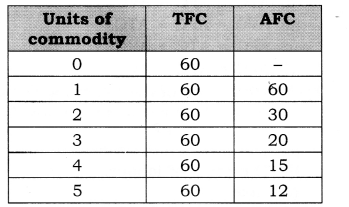
AFC falls as output increases because
AFC=TFCOutput and TFC remains constant.So, as output increases, TFC remains constant, AFC falls.
Question 4. Distinguish between variable cost and fixed cost. Give two examples of each.[AI 2004, 08; CBSE 99C, 2000C]
Answer:
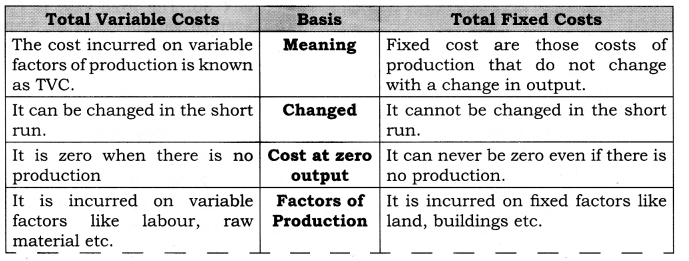

Question 5. Why is AC curve U-shaped in short run? Or
Why is AC curve U-shaped?[AI 2006; CBSE 07C, 10Q]
Answer: Average Cost is U-Shaped because of Law of variable proportion:
(i) The shape of average cost (AC) depends upon total cost (TC).
(ii) Initially, total cost (TC) increases at a diminishing rate (Total Product increases at Increasing rate), which makes its average, i.e., average cost (AC) to fall, then reaches its minimum point.
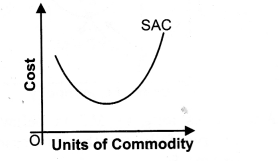
(iii) Thereafter, total cost (TC) increases at increasing rate (Total Product increases at diminishing rate), which makes the average cost (AC) to rise. This type of production behaviour shows operation of law of variable proportion.
Question 6. An individual is both the owner and the manager of a shop taken on rent. Identify implicit cost and explicit cost from this information. Explain. [CBSE 2012]
Answer: (i) For producing a commodity, a firm requires factor inputs (like services of land, labour, capital etc.) and non-factor inputs (like raw material, electricity, fuel etc.).
(ii) Actual money spent by a firm on buying and hiring of factor and non¬factor inputs is called explicit cost. As per question, rent paid for the shop is an explicit cost.
(iii) Implicit cost is the imputed or estimated value of inputs supplied by the owner of the firm himself. As, per question, imputed salary of the owner working as manager, imputed interest on self-supplied capital, etc. are implicit costs.
cost and implicit cost.
Question 7. State the distinction between explicit each.Give an example of each?
Answer:
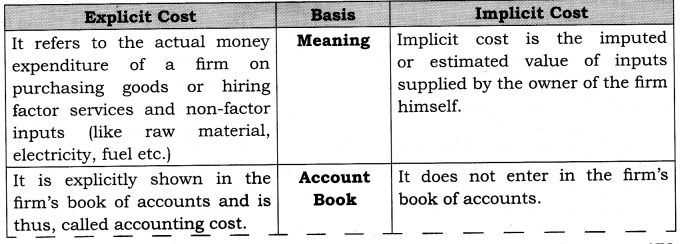

Question 8. A producer starts a business by investing his own savings and hiring the labour. Identify implicit and explicit costs from this information. Explain. [AI 2012]
Answer: (i) For producing a commodity, a firm requires factor inputs (like services of land, labour, capital etc.) and non-factor inputs (like raw material, electricity, fuel efc.).
(ii) Actual money spent by a firm on buying and hiring of factor and non¬factor inputs is called explicit cost. As per question, a producer is hiring the labour, than the wages and salary paid to labour is a explicit cost.
(iii) Implicit cost is the imputed or estimated value of inputs supplied by the owner of the firm himself. As, per question, if a producers start a business by investing his own savings, than the imputed interest on self-supplied capital he earned is a implicit cost.
Question 9. A farmer takes a farm on rent and carries on farming with the help of his family members. Identify explicit and implicit costs from this information. Explain. [AI 2012]
Answer: (i) For producing a commodity, a firm requires factor inputs (like services of land, labour, capital etc.) and non-factor inputs (like raw material, electricity, fuel etc.).
(ii) Actual money spent by a firm on buying and hiring of factor and non¬factor inputs is called explicit cost. As per question, a farmer takes a farm on rent. So, the rent he pays to landloard is the explicit cost.
(iii) Implicit cost is the imputed or estimated value of inputs supplied , by the owner of the firm himself. As per question, if a farmer carries on farming with the help of family members, even then the imputed wages will be an implicit cost.
Question 10. Explain the relationship between AC and MC with the help of a diagram.
[CBSE 2000C, 2001, 07, 07C, 09C; AI 2004, 08, 11]
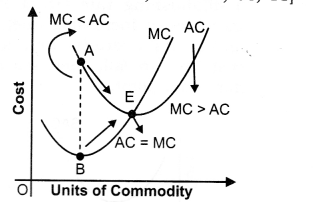
Answer: (i) As long as MC is below AC, AC curve falls till their intersection at point E.
(ii) When MC curve comes to fall, it falls more rapidly than AC curve and reaches its minimum point B earlier than the AC curve reaches its minimum point E.
Therefore, MC curve is rising from B to E whereas AC curve is still falling from A to E.
(iii) When MC curve is rising, it cuts the AC curve at its minimum point E and after that point MC is above than AC.
Question 11. Define cost. State the relation between marginal cost and average variable cost. [CBSE 2015]
Answer: Cost is the sum total of explicit cost, implicit cost and certain minimum profit (normal profit).
(i) As long as MC is below AVC, AVC curve falls till their intersection at point E.
(ii) When MC curve comes to fall, it falls more rapidly than AVC curve and reaches its minimum point B earlier than the AVC curve reaches its minimum point E.
Therefore, MC curve is rising from B to E whereas AVC curve is still falling from A to E.
(iii) When MC curve is rising, it cuts the AVC curve at its minimum point E and after that point MC is above than AVC.
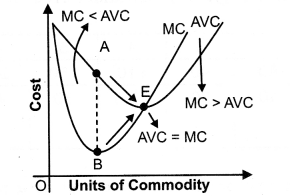
Question 12. What is the behaviour of (a) Average Fixed Cost and (b) Average Variable Cost as more and more units of a good are produced? [A1 2015]
Answer: (a) The average fixed cost falls as more and more units of goods are produced. It is so because average fixed cost is equal to . Total Fixed Cost (TFC)
Output
and total fixed cost remains constant with increase in level of output. So, with constant total fixed cost and increasing output, the average fixed cost falls.
(b) Average Variable Cost (AVC) is U-shaped with increase in output because of Law of Variable Proportion.
(i) As we know the shape of AVC depends upon the shape of Total Variable Cost (TVC). Initially, TVC increases at diminishing rate (because Total Product Increases at increasing Rate), that makes the AVC to fall.
(ii) Thereafter, TVC increases at increasing rate (because Total Product Increases at diminishing Rate), that makes the average variable cost to rise.
(iii) So, from inverse S-shape, TVC curve, we derive the U shape AVC curve.
Question 13. Can MC increase when AC falls?
Answer: Yes, it can happen when MC is below, than AC at the time of MC increases. The reason is that MC is confined to only one unit of the commodity produced whereas AC is related to all the units of commodity produced. As a result when MC increase, in case of MC, the whole increase is confined to the concerned one unit but in case of AC, this increase is shared by all the units of commodity produced. As the result of, rising MC is unable to bring about an increase in AC.
Question 14. Find out the total fixed cost in the following:
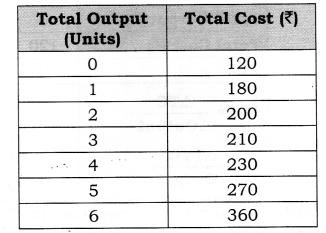
Answer: The total fixed cost will be the same at all the levels of output, ranging from zero to six. For zero output, total cost is Rs 120. At zero output, total variable cost will be zero. Hence, Rs 120 represents total fixed cost at all levels of output.

